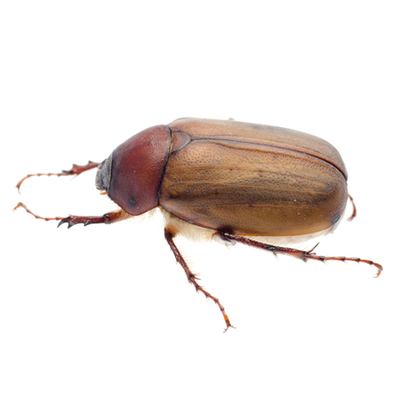Color: The front of the beetle is dark metallic green. Its wing covers are a metalic dark tan.
Size: Approximately 3/8 inches in length.
Grub: Below ground.
Adult: Above ground feed on leaves of plants.
The adult beetles normally emerge during the last week of June through July. The first beetles out of the ground seek out suitable food plants and begin to feed. These early arrivals begin to release an aggregation pheromone (odor) that attracts additional adults. Newly emerged females also release a sex pheromone that attracts males. After feeding and mating for a day or two, the females burrow into the soil to lay eggs at a depth of 2 to 4 inches. Females lay 1 to 5 eggs before returning to plants to feed and mate. This cycle of feeding, mating and egg laying continues until the female has laid 40 to 60 eggs. Most of the eggs are laid by mid-August though adults may be found until the first frost. The eggs hatch in 8 to 14 days and the first instar larvae dig to the soil surface to feed on roots and organic material. The first instars shed their skin (molt) in 17 to 25 days. The second instars take 18 to 45 days to mature and molt again. Most of the grubs are in the third instar by late September and by October they dig deeper into the soil to overwinter. The grubs return to the surface in the spring as the soil temperature warms, usually in mid-April. The grubs continue their development and form a pupa in an earthen cell 1 to 3 inches in the soil.
The adults will eat most anything however their food of choice includes: flowers, fruit trees, roses and raspberries. They skeletonize foliage giving it the characteristic lacy look. The grubs chew on the roots of plants which is often seen in turf area damage. If you encounter a dead area of grass and can lift it right up you will probably find the Japanese beetle grubs to be the culprit.
Japanese beetles can feed on about 300 species of plants, ranging from roses to poison ivy. Odor and location in direct sun seem to be very important factors in plant selection. The beetles usually feed in groups, starting at the top of a plant and working downward. While a single beetle doesn't eat much; group feeding by many causes severe damage. Adults feed on the upper surface of foliage, chewing out tissue between the veins. This gives the leaf a characteristic skeletonized appearance.
- Cultural Control — Plant Selection. Japanese beetles have been documented to damage a wide range of landscape plants. By selecting resistant or less-preferred plant material, Japanese beetle infestations can be reduced and damage minimized.
Trees and shrubs most attractive to adults Include: Japanese and Norway maple, birch, pin oak, horse chestnut, rose of sharon, sycamore, ornamental apple, plum, cherry, rose, mountain ash, willows, lindens, elms and Virginia creeper.
Trees and shrubs rarely attacked include: Red and silver maple, holly, boxwood, euonymus, flowering dogwood, cedar, juniper, arborvitae, red oak, tulip tree, magnolias, red mulberry, forsythia, ashes, privet, lilac, spruces, hydrangeas and taxus (yew).
Repellent plants: Catnip, chives, garlic, tansy and rue.
Resistant plants: Box elder. Common lilac, Firs, Hemlocks, Hollies, Pines, Rhododendrons, Spruces, Scarlet oak, Tulip tree, White ash, White poplar and Yews.
- For easier handpicking: In the morning spread out a sheet under infested plants. Shake the plants and the beetles will fall onto the sheet. Dump them into a bucket of soapy water. Dew on their wings in the morning keeps them from flying away. The cooler air also makes them more lethargic.
- Japanese Beetle Trap and Bait
The following bait and trap method is to be used during the height of the Japanese Beetle season.
Ingredients:
1 cup water
1/4 cup sugar
1 mashed banana
1 pkg yeast
Dissolve sugar and yeast in the water. Mix the well maxhed banana into the sugar water. Put all ingredients in a gallon milk jug. Place the jug (with the top off) in an area where Japanese Beetles gather. The fermentation and odor of the bait attracts the beetles which get in but not out.
- Good plants for trap crops include: evening primrose, soybeans, wild grapes, African marigolds, borage and knotweed!
-
Use interplantings of four o'clocks (Mirabilis), larkspur, white geraniums, red (and dwarf) buckeyes whose flowers attract and poison the beetles. The leaves of the castor bean plant also poison them. These plants are poisonous to people to so be careful using them around children or pets!
- Trap crops for the beetles are African marigold, borage, evening primrose (oonthera), four o'clocks, knotweed, soybeans, white roses, white and pastel zinnias, wild grapes and blackberries.
-
Predators: Starlings...yes, those pesky starlings love to dine on Japanese beetles! Tachnid flies and tiphia wasps kill them. Native birds and chickens will feed on the larvae. You can help the birds along by turning the soil in autumn to expose the larva.


















